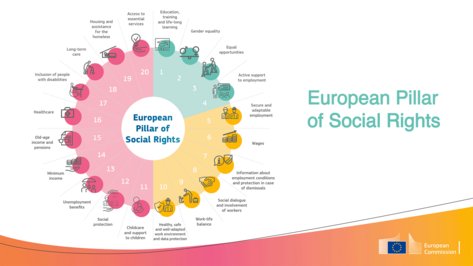The birth of the EPSR
The discussion initiated by the five Presidents on a deepening of the common policy in the areas of labour and social affairs was put in concrete terms by the European Commission with the presentation of its ideas for an EPSR in spring 2016. In doing so, the proposal aimed at a first realisation in the Eurozone, analogous to the Five Presidents’ Report.
ed* Nr. 03/2022 – Chapter 3
During the discussion with the Member States, it became clear how much the economic and financial crisis has exposed the weaknesses of social protection in Europe. Europe had done much to rescue banking institutions and control government spending policies, but little to provide social security for its citizens. However, many Member States were critical of the transfer of competences for social protection, and thus, also social insurance, to the European level as proposed in the Five Presidents’ Report. The restriction to the eurozone was also not consensual. In the end, the European Commission abandoned this restriction. The EPSR is addressed to all Member States.

For the then European Commission President Juncker, the proclamation of the EPSR on 17 November 2017 was a decisive moment for Europe. He always saw the European Union also as a social project and not only as the result of a common internal market. For him, it was about more than money, more than the euro. “It is about our values and the way we want to live“.1
With the establishment of the EPSR, the European Commission, the European Council and the European Parliament have found a new modus operandi for deeper cooperation in the field of social protection. The EPSR should serve as a compass for a strong social Europe for all Member States. The aim is to improve working and living conditions across Europe, reduce social inequalities, thus contributing to a new process of economic recovery in the EU.
The EU or the Member States – a tussle of who is in charge
The EPSR does not involve a direct transfer of national responsibilities to the EU level. However, the common principles are to be anchored in the processes of the EU, thus justifying major European initiatives and proposals for directives. These can also contain legally binding minimum standards, as is already the case today in the field of occupational health and safety, for example. However, the aim is not to standardise the different national social security systems. The European social model is not defined by systems that are standardised across the EU, but by common principles and objectives. Thus, the realisation of the EPSR is the joint responsibility of all stakeholders at both European and national level.
Major achievements for social security
With the adoption of the EPSR, the need for new legislative and non-legislative initiatives was also worded. At the Social Summit in Porto 2021, the EU agreed on an action plan for the further implementation of the EPSR until the end of the term of the current European Commission. It announces European initiatives to accelerate the implementation of the EPSR. In addition, the challenges in the areas of climate change, digitisation, globalisation and demographic development are to be specifically addressed. In continuation of the EU2020 strategy, three goals are underpinned with specific targets: employment, training and poverty reduction.
But how has the EPSR actually been reflected in initiatives at the European level in recent years? Could existing gaps in social security be closed? How have the different policy fields on health and care, pensions and occupational health and safety developed? Here it is worth taking a look at essential measures in the area of social security.

